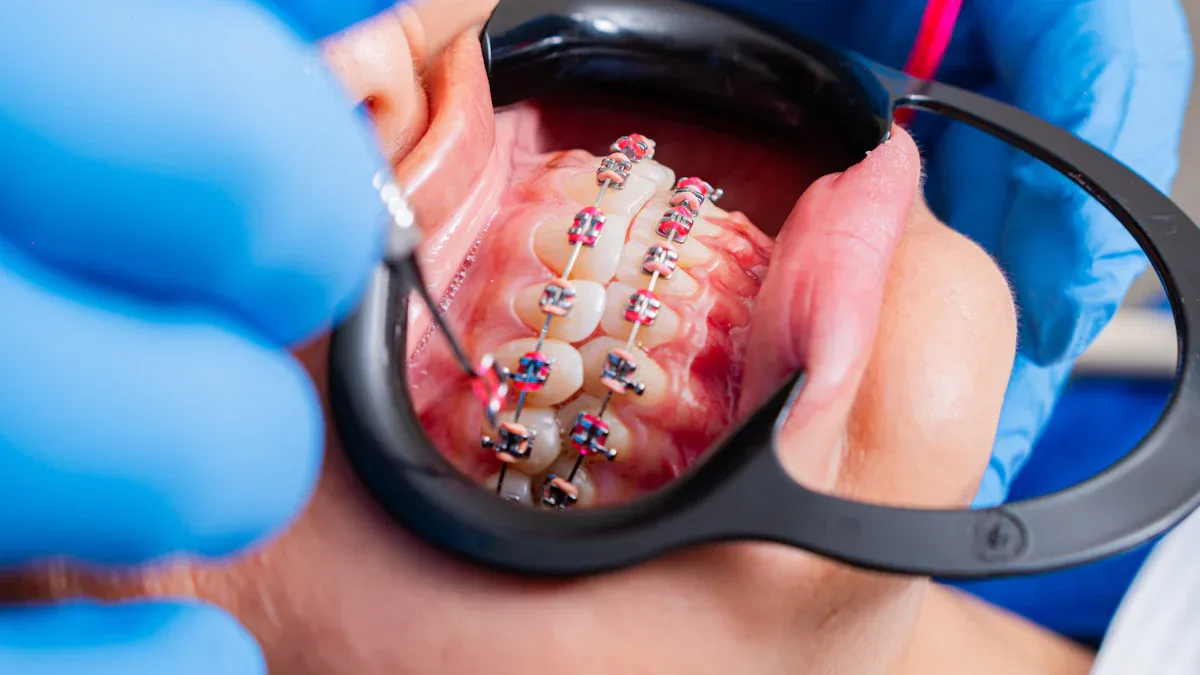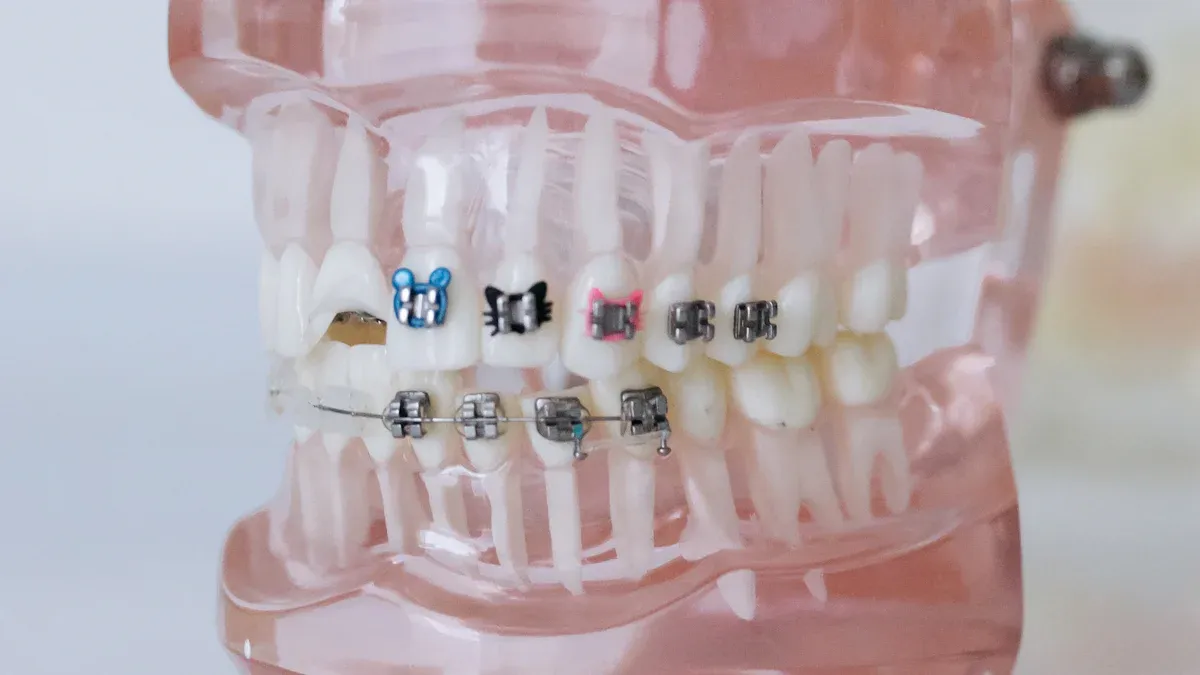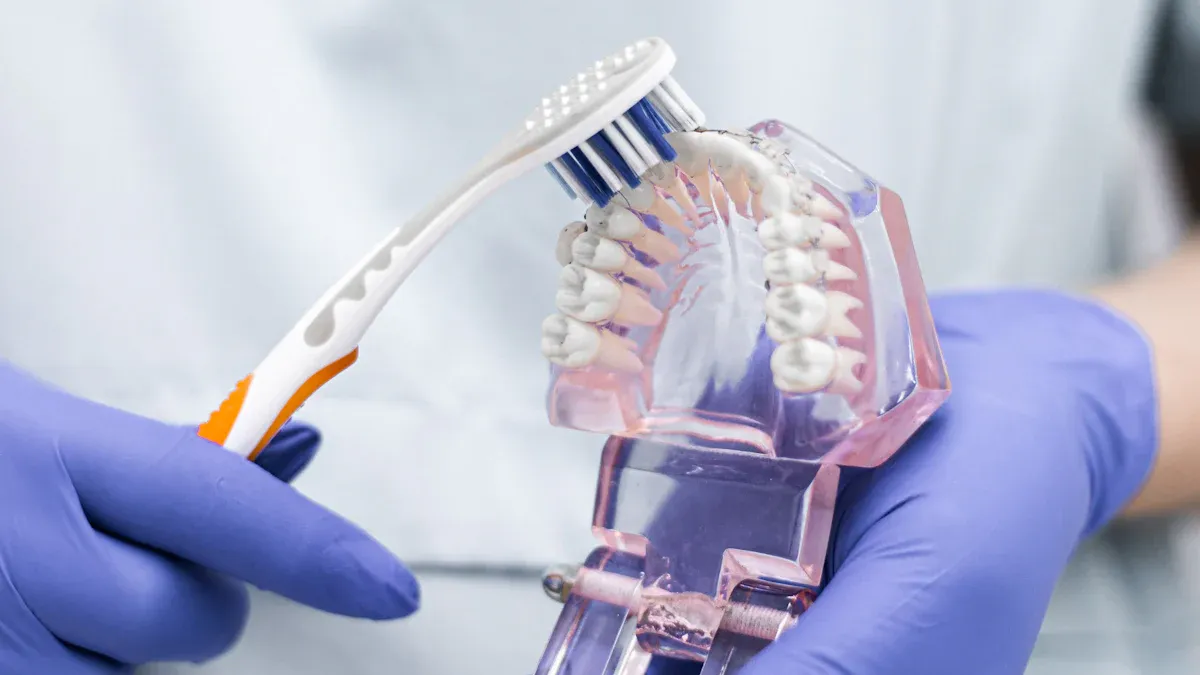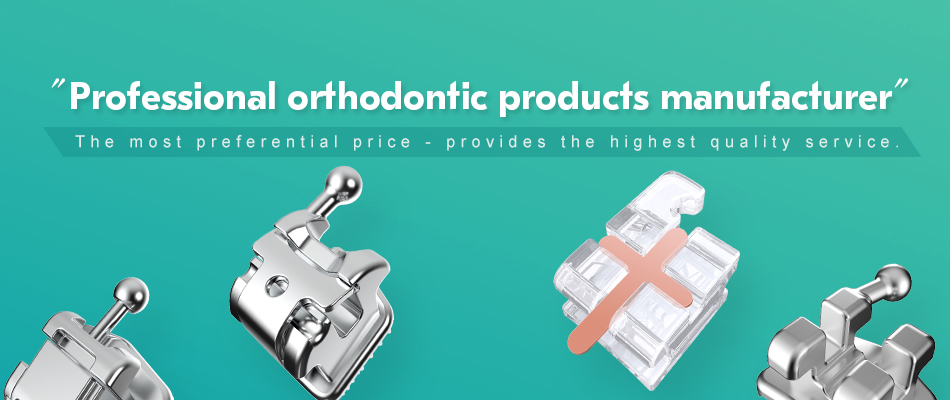
Selecting reliable orthodontic bracket manufacturers is crucial for ensuring patient safety and maintaining a strong business reputation. Poor supplier choices can lead to significant risks, including compromised treatment outcomes and financial losses. For instance:
- 75% of orthodontists report improved patient results when using high-quality materials.
- Product failures can result in financial liabilities ranging from $10,000 to $50,000 per incident.
A structured supplier evaluation process minimizes these risks. It helps businesses identify manufacturers who prioritize quality, innovation, and compliance, fostering long-term success in the orthodontic industry.
Key Takeaways
- Choose manufacturers with ISO certifications to ensure good quality and global standards.
- Check if the supplier has enough tools and capacity to meet demand without lowering quality.
- Read customer reviews and check awards to find trusted manufacturers with good history.
- Pick brackets made from safe materials to avoid allergies and keep patients comfortable.
- Find manufacturers with clear prices and great customer service for lasting partnerships.
Key Criteria for Choosing Orthodontic Bracket Manufacturers
Certifications and Standards
Importance of ISO Certifications
Certifications play a vital role in establishing the credibility of orthodontic bracket manufacturers. ISO certifications, such as ISO 9001:2015, ensure that manufacturers maintain robust quality management systems. Similarly, ISO 13485:2016 focuses on consistent product quality and customer satisfaction, which are essential in orthodontic bracket production. These certifications demonstrate a manufacturer’s commitment to excellence and adherence to global standards.
Compliance with FDA and Other Regulatory Bodies
Regulatory compliance is another critical factor when evaluating manufacturers. For instance, the EU MDR certification verifies that a company meets stringent medical device regulations. Achieving this certification, which fewer than 10% of medical device companies obtain, reflects a high standard of compliance. Manufacturers must also adhere to FDA guidelines to ensure their products meet safety and efficacy requirements. These measures protect patients and enhance trust in the supplier’s products.
Manufacturing Capabilities
Production Capacity and Scalability
A reliable manufacturer must demonstrate the ability to meet demand without compromising quality. Companies like Denrotary Medical, equipped with advanced production lines, can produce up to 10,000 orthodontic brackets weekly. This scalability ensures consistent supply, even during periods of high demand. Businesses should prioritize manufacturers with proven capacity to handle large-scale production efficiently.
Use of Advanced Technology in Manufacturing
The integration of advanced technology in manufacturing processes is essential for producing high-quality orthodontic brackets. Leading manufacturers utilize state-of-the-art equipment, such as those imported from Germany, to enhance precision and efficiency. These technologies enable the production of brackets that meet the highest standards of durability and performance, ensuring better outcomes for patients.
Innovation and Research
Focus on Product Development and Improvement
Investment in research and development drives innovation in orthodontic bracket design. Companies that prioritize R&D create advanced solutions tailored to the needs of patients and orthodontists. For example, the global orthodontic brackets market, valued at USD 3.2 billion in 2023, is projected to grow at a CAGR of 6.9% due to advancements in technology and rising demand. This growth underscores the importance of continuous product improvement.
Collaboration with Dental Professionals
Collaboration with dental professionals fosters innovation and ensures that products align with clinical needs. Industry leaders like Dental Monitoring SAS and Dentsply Sirona Inc. set benchmarks by blending traditional orthodontic methods with digital technologies. Such partnerships result in improved bracket designs that enhance comfort, aesthetics, and treatment efficiency. Manufacturers committed to collaboration often lead the way in delivering cutting-edge solutions.
Evaluating Product Quality and Materials

Types of Orthodontic Brackets
Metal, Ceramic, and Self-Ligating Brackets
Orthodontic brackets come in various types, each catering to specific patient needs. Metal brackets remain the most widely used due to their durability and affordability. These brackets are particularly popular among children and teenagers. Ceramic brackets, on the other hand, offer a more aesthetic option. Their tooth-colored appearance makes them a preferred choice for adults, despite their higher cost. Self-ligating brackets, a newer innovation, are gaining traction for their reduced friction and shorter treatment times. These brackets are expected to see significant growth as technology advances.
Advantages and Disadvantages of Each Type
Each type of bracket has its strengths and limitations. Metal brackets excel in strength and cost-effectiveness but lack aesthetic appeal. Ceramic brackets blend seamlessly with natural teeth, enhancing confidence during treatment, though they may be more prone to chipping. Self-ligating brackets reduce the need for elastic ties, improving hygiene and comfort, but they often come at a higher price point. Understanding these factors helps orthodontic bracket manufacturers and practitioners recommend the best options for patients.
Durability and Performance
Resistance to Wear and Tear
Durability is a critical factor in evaluating orthodontic brackets. High-quality brackets resist wear and tear, ensuring they remain functional throughout the treatment period. Manufacturers adhering to ANSI/ADA Standard No. 100 meet stringent requirements for functional dimensions and chemical ion release, ensuring robust performance.
Long-Term Clinical Performance
Orthodontic brackets must maintain their integrity over extended periods. ISO 27020:2019 compliance ensures that brackets meet international standards for long-term use. This guarantees consistent clinical outcomes, reducing the likelihood of treatment disruptions.
Material Safety
Ensuring Biocompatibility and Safety
Material safety is paramount in orthodontics. Alumina brackets, for instance, are chemically inert and free from cytotoxicity. They do not release metal ions, minimizing the risk of toxicity or allergic reactions. These properties enhance patient comfort and promote faster healing of gum tissues.
Testing for Allergies or Adverse Reactions
Manufacturers must conduct rigorous testing to ensure their products are safe for all patients. Compliance with standards like ANSI/ADA and ISO ensures that brackets undergo thorough evaluations for biocompatibility. This reduces the risk of adverse reactions, safeguarding patient health.
Assessing Supplier Reputation and Experience

Customer Feedback
Importance of Testimonials and Reviews
Customer feedback serves as a vital indicator of a supplier’s reliability. Positive testimonials and reviews highlight a manufacturer’s ability to meet client expectations consistently. They also provide insights into product quality, delivery timelines, and customer service. Businesses should prioritize orthodontic bracket manufacturers with a strong track record of satisfied clients. Verified reviews on platforms like Trustpilot or Google Reviews can offer unbiased perspectives, helping buyers make informed decisions.
Identifying Red Flags in Feedback
Negative feedback often reveals potential issues with a supplier. Complaints about delayed shipments, inconsistent product quality, or poor customer support should raise concerns. Patterns of unresolved issues or defensive responses to criticism may indicate a lack of accountability. Companies must analyze feedback critically to identify these red flags and avoid unreliable suppliers.
Industry Recognition
Awards and Certifications from Reputable Organizations
Industry recognition reflects a manufacturer’s commitment to excellence. Awards from respected organizations validate their achievements in innovation, quality, or customer satisfaction. For example, certifications from dental associations or medical device authorities demonstrate adherence to high standards. Recognized orthodontic bracket manufacturers often stand out as leaders in their field.
Partnerships with Leading Dental Institutions
Collaborations with renowned dental institutions enhance a supplier’s credibility. These partnerships often involve research initiatives, product testing, or educational programs. Manufacturers working closely with dental professionals gain valuable insights into clinical needs, resulting in superior product development. Such alliances signify a supplier’s dedication to advancing orthodontic care.
Longevity and Stability
Years of Experience in the Industry
A supplier’s experience often correlates with their expertise and reliability. Companies with a long history in orthodontic manufacturing have likely refined their processes and built strong client relationships. For instance, Denrotary Medical, established in 2012, has over a decade of experience in producing high-quality orthodontic products. This longevity demonstrates their ability to adapt and thrive in a competitive market.
Financial Stability and Reliability
Financial stability ensures a supplier can maintain operations and fulfill commitments. Reliable manufacturers invest in advanced technology, skilled personnel, and quality assurance processes. Businesses should evaluate financial reports or credit ratings to assess a supplier’s stability. A financially sound company minimizes risks of supply chain disruptions, ensuring consistent product availability.
Quality Management and Compliance
Quality Assurance Processes
Regular Testing and Inspection Protocols
Orthodontic bracket manufacturers must implement rigorous testing and inspection protocols to ensure product reliability. Regular evaluations help identify defects early, reducing the risk of faulty products reaching the market. Advanced testing equipment, such as precision measuring tools and stress-testing machines, ensures brackets meet durability and performance standards. These measures safeguard patient outcomes and maintain the manufacturer’s reputation for quality.
Documentation of Quality Control Measures
Comprehensive documentation of quality control measures is essential for maintaining transparency and accountability. Manufacturers should maintain detailed records of production processes, testing results, and corrective actions. These documents serve as evidence of compliance during audits and inspections. Companies with robust documentation practices demonstrate their commitment to consistent quality and regulatory adherence.
Regulatory Compliance
Adherence to Local and International Regulations
Compliance with local and international regulations ensures the safety and effectiveness of orthodontic brackets. Leading manufacturers adhere to certifications such as EU MDR, ISO 13485:2016, and FDA regulations. These certifications validate that products meet stringent safety and quality standards.
| Certification | Description |
|---|---|
| EU MDR | Ensures compliance with European medical device regulations for safety and effectiveness. |
| ISO 13485:2016 | International standard for Quality Management Systems in medical devices, ensuring safety and quality. |
| FDA Regulations | U.S. regulations that ensure medical devices meet safety and effectiveness standards. |
Manufacturers meeting these standards build trust with clients and healthcare professionals.
Handling Recalls and Compliance Issues
Effective handling of recalls and compliance issues reflects a manufacturer’s reliability. Companies must establish clear protocols for addressing product defects or regulatory violations. Swift action minimizes risks to patients and protects the manufacturer’s reputation. Transparent communication during recalls fosters trust and demonstrates accountability.
Risk Management
Contingency Plans for Supply Chain Disruptions
Supply chain disruptions can impact the availability of orthodontic brackets. Reliable manufacturers develop contingency plans to mitigate these risks. Strategies include maintaining inventory buffers, diversifying suppliers, and leveraging advanced logistics systems. These measures ensure uninterrupted supply, even during unforeseen challenges.
Transparency in Addressing Quality Concerns
Transparency is critical when addressing quality concerns. Manufacturers should openly communicate with clients about potential issues and corrective actions. Proactive engagement builds confidence and strengthens partnerships. Companies prioritizing transparency demonstrate their commitment to delivering safe and effective products.
Pricing and Support Services
Transparent Pricing
Avoiding Hidden Fees or Unexpected Costs
Transparent pricing is a cornerstone of trust between manufacturers and clients. Reliable orthodontic bracket manufacturers provide clear and upfront pricing details, eliminating the risk of hidden fees or unexpected costs. This transparency ensures that clients can budget effectively and avoid unpleasant surprises. Manufacturers who prioritize open communication about costs demonstrate their commitment to building long-term partnerships.
Comparing Pricing with Competitors
Competitive pricing analysis helps businesses identify manufacturers offering the best value. Comparing costs across multiple suppliers ensures that clients receive high-quality products at reasonable rates. For instance, manufacturers like Denrotary Medical, with advanced production capabilities, can offer cost-effective solutions without compromising quality. This balance of affordability and excellence makes them a preferred choice in the orthodontic industry.
Customer Support
Availability of Technical Support
Exceptional customer support enhances the overall client experience. Manufacturers must provide accessible technical support to address any product-related concerns. A dedicated support team ensures that orthodontists can resolve issues quickly, minimizing disruptions to patient care. Companies with robust support systems often stand out as reliable partners in the orthodontic field.
Responsiveness to Inquiries and Issues
Timely responses to inquiries reflect a manufacturer’s professionalism and reliability. Clients value suppliers who address their concerns promptly and effectively. Quick resolution of issues fosters trust and strengthens business relationships. Manufacturers like Denrotary Medical, known for their customer-first approach, exemplify this commitment by prioritizing client satisfaction at every stage.
Customization Options
Meeting Specific Client Needs
Customization plays a vital role in meeting diverse client requirements. Manufacturers offering tailored solutions cater to the unique needs of orthodontists and their patients. For example, the orthodontic brackets market increasingly emphasizes product diversification to address the preferences of various age groups. This trend underscores the importance of personalized solutions in achieving better treatment outcomes.
| Metric | Insight |
|---|---|
| Price Sensitivity | 70% of potential orthodontic patients consider price a critical factor in their decisions. |
| Unique Offerings | Customized solutions like Lightforce’s 3D-printed brackets create differentiation in the market. |
| Customization and Diversification | Manufacturers are focusing on tailored solutions to meet diverse client needs across age groups. |
Offering Tailored Solutions
Tailored solutions differentiate manufacturers in a competitive market. Customization reduces direct comparisons and enhances client satisfaction. Companies investing in advanced technologies, such as 3D printing, deliver unique offerings that align with specific clinical needs. This focus on innovation and personalization positions manufacturers as leaders in the orthodontic industry.
Choosing reliable orthodontic bracket manufacturers involves evaluating certifications, manufacturing capabilities, product quality, and supplier reputation. Thorough research ensures better patient outcomes and minimizes risks.
- High-quality materials improve treatment results for 75% of orthodontists.
- Poor supplier selection can lead to financial liabilities ranging from $10,000 to $50,000 per product failure.
Businesses should apply this guide to identify trustworthy suppliers who prioritize quality, innovation, and compliance. A structured approach fosters long-term success and strengthens partnerships in the orthodontic industry.
FAQ
What certifications should orthodontic bracket manufacturers have?
Manufacturers should hold ISO 13485:2016 for quality management and FDA approval for safety and efficacy. EU MDR certification is also essential for compliance with European medical device regulations. These certifications ensure adherence to global standards and patient safety.
How can businesses assess a supplier’s reputation?
Businesses can evaluate reputation by reviewing customer testimonials, analyzing industry awards, and checking partnerships with dental institutions. Positive feedback and recognition from reputable organizations indicate reliability and expertise in orthodontic manufacturing.
Why is material safety important in orthodontic brackets?
Material safety ensures biocompatibility, reducing risks of allergies or adverse reactions. High-quality materials, such as alumina, are chemically inert and non-toxic. Safe materials enhance patient comfort and promote successful treatment outcomes.
What role does advanced technology play in manufacturing?
Advanced technology improves precision, efficiency, and product quality. Manufacturers using state-of-the-art equipment, like German-imported machinery, produce durable and high-performing brackets. This ensures better clinical outcomes and customer satisfaction.
How can manufacturers support customization needs?
Manufacturers can offer tailored solutions by leveraging technologies like 3D printing. Customization addresses specific clinical requirements, enhances patient satisfaction, and differentiates suppliers in the competitive orthodontic market.
Post time: Mar-21-2025


